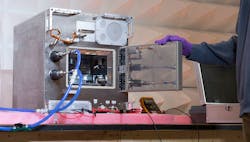Advanced Printer Reuses 3D Parts on Space Station
Transported onboard a Cygus spacecraft from Northrop Grumman to the International Space Station (ISS) in November, the Refabricator is a different type of 3D printer that can turn waste plastic and previously printed 3D parts into 3D printer filament or 3D printing ink for reuse. Well-suited for resource-limited applications such as within the ISS, the Refabricator 3D printer provides the means to reuse materials many times to create new tools and components. The system (see figure) is designed and manufactured by Tethers Unlimited Inc. (TUI) of Seattle, Wash.
The Refabricator is a unique 3D printer that can form new parts and components while working with used parts and reused materials. (Courtesy of NASA)
The Refabricator was used as part of a recent demonstration to evaluate the quality of parts manufactured with reused materials. It was produced for NASA as part of a Small Business Innovation Research contract to TUI and completed final flight certification testing at NASA’s Marshall Space Flight Center in Huntsville, Ala. Refabricator was launched from NASA’s Wallops Flight Facility on Virginia’s Eastern Shore. NASA feels the remanufacturing technology could prove invaluable for future deep-space exploration, including missions to the Moon and Mars.
About the Author
Jack Browne
Technical Contributor
Jack Browne, Technical Contributor, has worked in technical publishing for over 30 years. He managed the content and production of three technical journals while at the American Institute of Physics, including Medical Physics and the Journal of Vacuum Science & Technology. He has been a Publisher and Editor for Penton Media, started the firm’s Wireless Symposium & Exhibition trade show in 1993, and currently serves as Technical Contributor for that company's Microwaves & RF magazine. Browne, who holds a BS in Mathematics from City College of New York and BA degrees in English and Philosophy from Fordham University, is a member of the IEEE.


